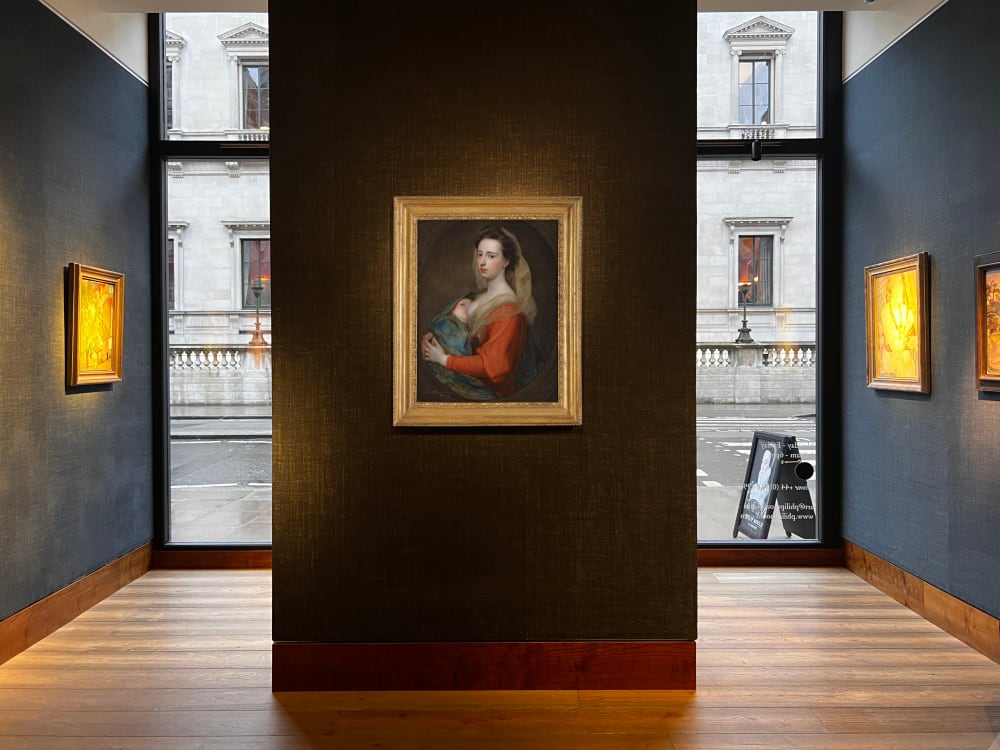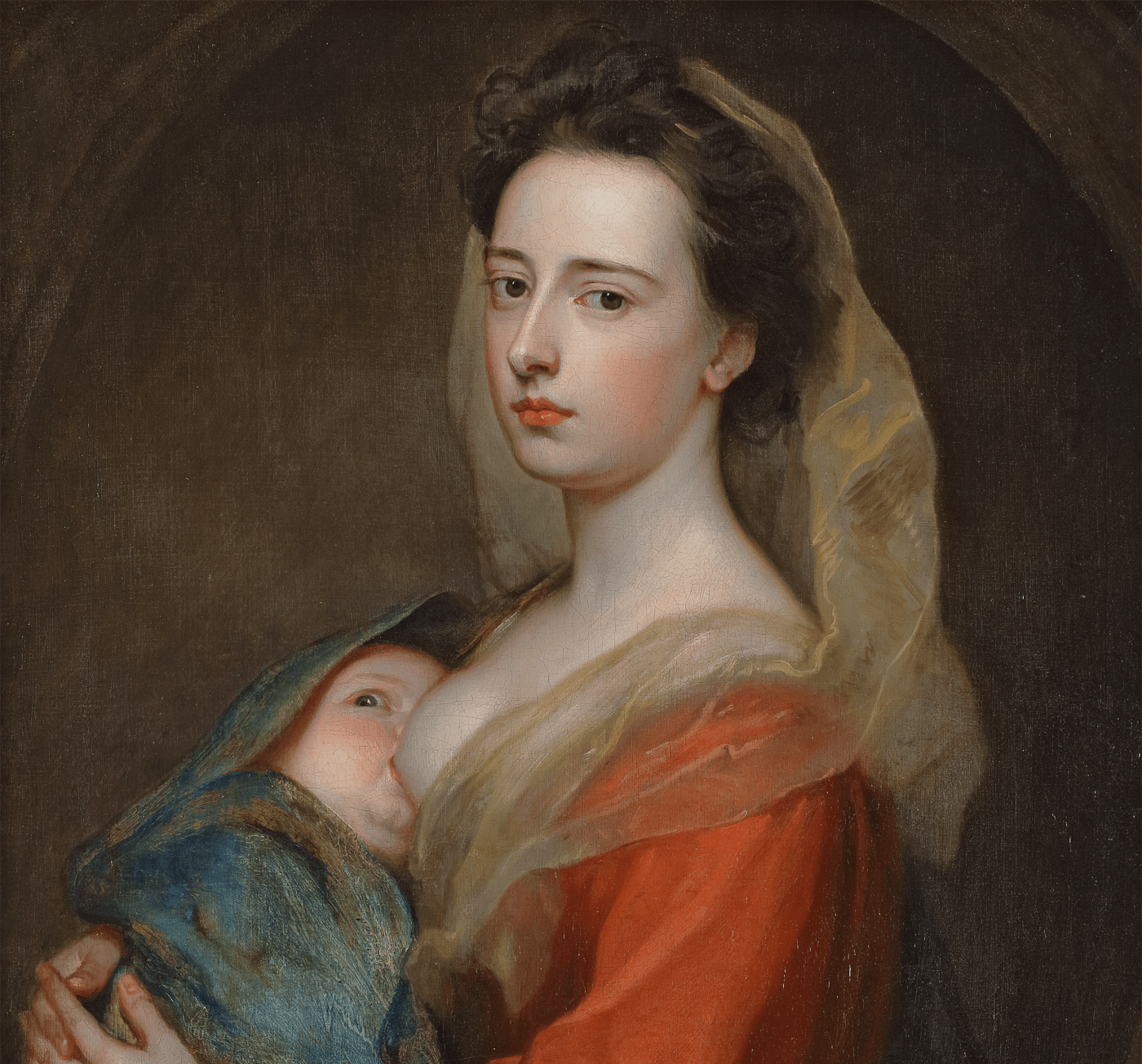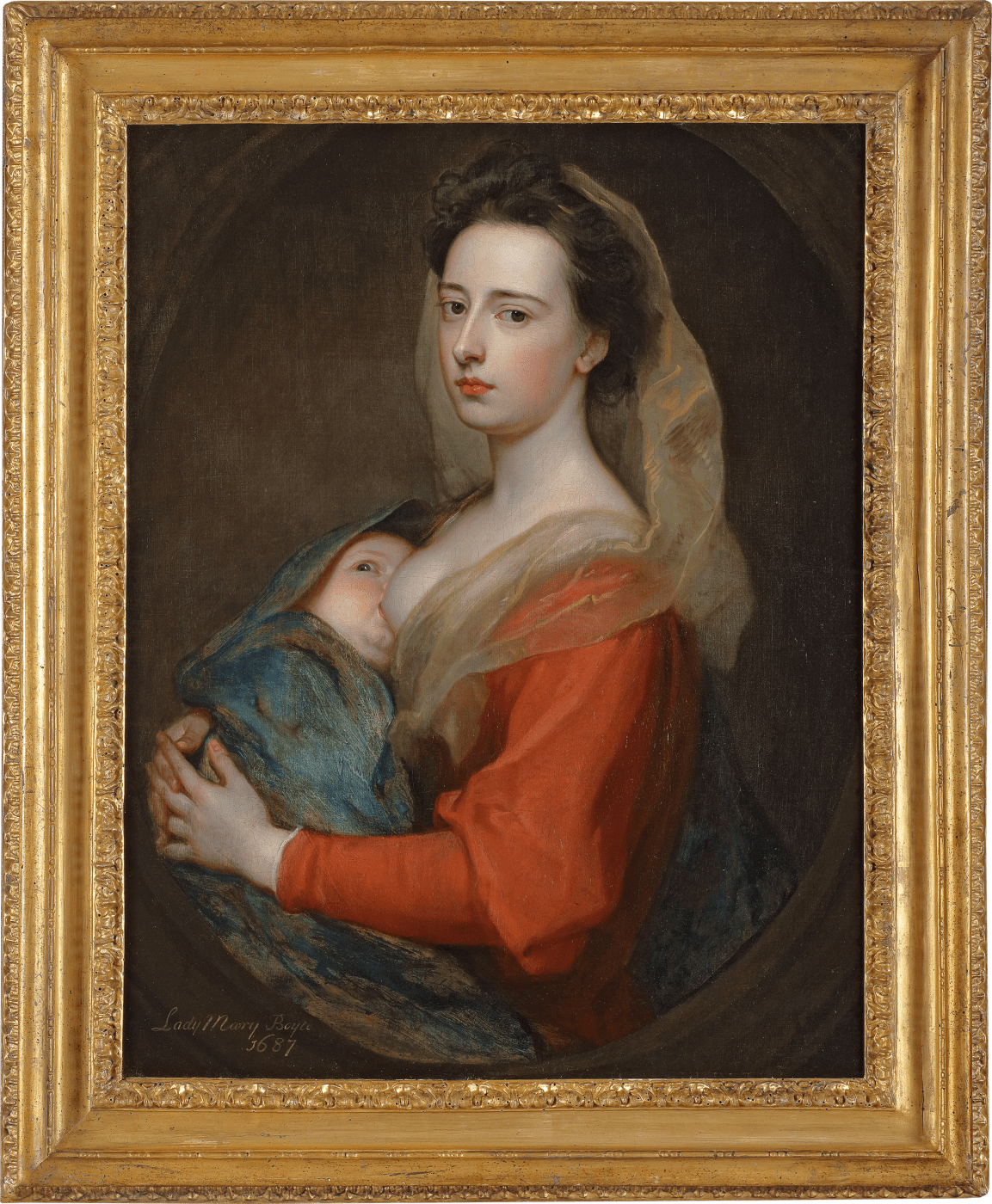A focused display of Sir Godfrey Kneller's Portrait of Lady Mary Boyle nursing her son Charles, 1690
From 19th December 2023 until 19th January 2024
Lady Mary Boyle nursing her son Charles, by the leading court artist Sir Godfrey Kneller is the earliest known painting of a mother breastfeeding her child in British and Irish portraiture. The intense naturalism of this portrait advances contemporary understanding of the changing role of motherhood throughout the early modern period, and to all present researchers, no immediately comparable work of portraiture is known.
This portrait, recently reserved by an American institution, will remain at our gallery until mid January specially displayed on the ground floor alongside information panels on the sitter and the history of breastfeeding in the seventeenth century.

Sir Godfrey Kneller
Portrait of Lady Mary Boyle nursing her son Charles, 1690
Oil on canvas, 32 ½ x 25 ¾ in. (82.5 x 65.4 cm)
This tender portrait by the leading court artist Sir Godfrey Kneller is the earliest known painting of a mother breastfeeding her child in British and Irish portraiture. Its significance lies in the exceptional combination of formal portrayal coupled with remarkable naturalism.
Portrayed with dignity and a firm gaze, Godfrey Kneller depicts Lady Mary Boyle, dressed in a red gown and transparent gauze veil, breastfeeding her third son, Charles. Mary was the daughter of Murrough O’Brien, 1st Earl of Inchiquin, who came from one of the most powerful families in Munster and was one of the few native Irish houses to claim direct descent from Brian Boru. She married the Hon Lt Col. Henry Boyle of Castlemartyr, Cork (second son of Roger Boyle, 1st Earl of Orrery) and had four sons and two daughters. The child shown here is Charles, who pursued a career in the Navy and gained the rank of Captain in January 1711. Following the death of Mary’s husband on active service with the Duke of Marlborough in 1693, she married Admiral Sir Thomas Dilkes MP [fig. 1], and later, at his death, Colonel John Irwin.
Kneller’s expert hand perfectly encapsulates the deep bond between mother and child in this work with striking realism. In comparison to the more widespread and less intimate tradition of mother and child portraiture, the artist captures Boyle and her son with anomalous clarity and animation. The wide-eyed expression on the child's face conveys the realities of nursing a newborn baby, and this intense naturalism adds to contemporary understanding of the changing role of motherhood throughout the early modern period.
Breastfeeding amongst the aristocracy at this time was largely uncommon within the British Isles. As was often customary within aristocratic families, the Boyle family had historically employed wetnurses.[1] Indeed, records in Richard Boyle's (Lady Mary Boyle’s grandfather-in-law) diary of gifts notes generous rewards for occupations such as god midwives, nurses and one 'nurse keeper'.[2] Wet nursing was a potentially lucrative profession for many lower-class women. However, societal pressures placed firm strictures on the ‘type’ of wetnurses that were deemed appropriate, and guidance on the employment of a ‘good’ wet nurse was published widely throughout the sixteenth and seventeenth centuries.[3] James Wolveridge, an English man-midwife and physician working in Ireland, published his Speculum Matricis Hybernicum in 1669, in which he detailed the qualities of an ‘ideal’ wet nurse as; ‘mild, chaste, sober, courteous, chearful, lively, neat, cleanly, and handy; because bad conditions, as well as good, are suck’d in with the milk’.[4]
The importance of a virtuous wet nurse was associated with the commonly held belief that the quality of a woman’s milk had the ability to alter the nature and character of the child who drank it.[5] As stated by Wolveridge, the character of the wetnurse was believed to have a direct impact on the child she breastfed; ‘children (like new vessels, which will keep the savour of that liquor they are first seasoned withal).’[6] This belief developed throughout the seventeenth century, and Protestant Puritan ministers in England became increasingly assertive in their insistence that a mother’s milk was the best option for a child’s welfare.[7] [8] Moreover, the nursing mother was becoming intimately tied to notions of the ‘good’ and ‘natural’ mother.[9] [10]
Within this fraught context, Lady Mary Boyle’s active participation in the act of breastfeeding her own child is highly exceptional. On one hand, the portrait signifies a bold demonstration of Boyle’s commitment to her role as a caring and nurturing mother (and thus subscribing to such transforming contemporary ideas regarding motherhood). On another hand, perhaps the painting might be read as a testament to Boyle’s Anglican beliefs at a time when Catholics were being prosecuted in Ireland. Boyle’s father, 1st Earl of Inchiquin, was born of Catholic parents but raised as a staunch Anglican, fighting against the Catholics in the Irish Rebellion of 1641 before converting to Catholicism during Cromwell’s final victory. Lady Mary Boyle, presumably born a Catholic, married the Anglican Hon Lt Col. Henry Boyle, the second son of Inchiquin’s lifelong rival, Roger Boyle, 1st Earl of Orrery.
Boyle’s family history of mixed denominations, consequently, may somewhat explain the seemingly contrasting iconography of the present portrait. Although contemporary religious advocacy of breastfeeding mothers was rooted in protestant theory, the present composition is undeniably reminiscent of the breastfeeding Virgin Mary, widespread within Catholic iconography. The expertly executed veil that graces the sitter’s head neatly aligns the sitter with symbolism often associated with the Virgin. Accordingly, Kneller himself had previously depicted the veiled Mary Magdalen and would therefore have been aware of the religious associations/connotations with the Virgin. Previous researchers have also noted references to the Virgin Mary as a play on the sitter’s name.
The iconographical references are heightened by the intense naturalism of Kneller’s expert hand. The bold handling of the flesh tones and the painterly technique, particularly apparent in the sitter’s veil, is an excellent exposition of Kneller’s esteemed style and presents the artist at his most emphatic. Kneller’s range and industry were unparalleled during his lifetime. He painted every monarch from Charles II to George I and his style had a powerful impact on succeeding generations; his longevity has awarded him the deserved title as Britain's most prolific portraitist. This portrait further enhances the artist’s already multifarious oeuvre.
[1] C. Tait, ‘Safely Delivered: Childbirth, Wet-nursing Gossip-Feasts and Churching in Ireland c.1530-1690’, Irish Economic and Social History, 2003, Vol. 30 (2003), p. 10.
[2] Lismore Papers, vol.1, i., pp. 37, 106, 133, ii., 228, iii., p. 179, v., pp. 169, 189, as quoted in C. Tait ‘Safely Delivered: Childbirth, Wet-nursing Gossip-Feasts and Churching in Ireland c.1530-1690’, Irish Economic and Social History, 2003, Vol. 30 (2003), p. 12 https://www.jstor.org/stable/24338985
[3] For examples see: T. Raynalde, The Byrth of Mankynd, Otherwyse Named the Womans Boke. London, 1552; J. Guillemeau, The Happy Delivery of Women. London, 1612; J. Sharp, The Midwives Book. London: S. Miller, 1671;
[4] J. Wolveridge, Speculum Matricis Hybernicum, 1669, p. 143 https://quod.lib.umich.edu/e/eebo2/A66881.0001.001/1:44?rgn=div1;view=fulltext
The belief that breast-milk was white blood contributed to the growing belief that the quality of a woman’s milk was subject to her nature and character. The character of the wetnurse could be transmitted to the child she breastfed via her milk.
[5] Shakespeare even referenced this phenomenon in his play The Winter’s Tale.
[6] J. Wolveridge, Speculum Matricis Hybernicum, 1669, p. 140. https://quod.lib.umich.edu/e/eebo2/A66881.0001.001/1:44?rgn=div1;view=fulltext
[7] S. Laurence, The Hand that Rocked the Cradle. Norwich: Unicorn Press, 2018, p. 104.
[8] For more on this topic, see also: D. Harley, 'From Providence to Nature: The Moral Theology and Godly Practic Breast-feeding in Stuart England', Bulletin of the History of Medicine, LXiX (1995), pp.198-223; Klapisch-Zuber, 'Blood Parents and Milk Parents'.
[9] D. Harley ‘From Providence to Nature: The Moral Theology and Godly Practice of Maternal Breast-feeding in Stuart England’, p. 221.
[10] S. Laurence, The Hand that Rocked the Cradle. Norwich: Unicorn Press, 2018, p. 104.








